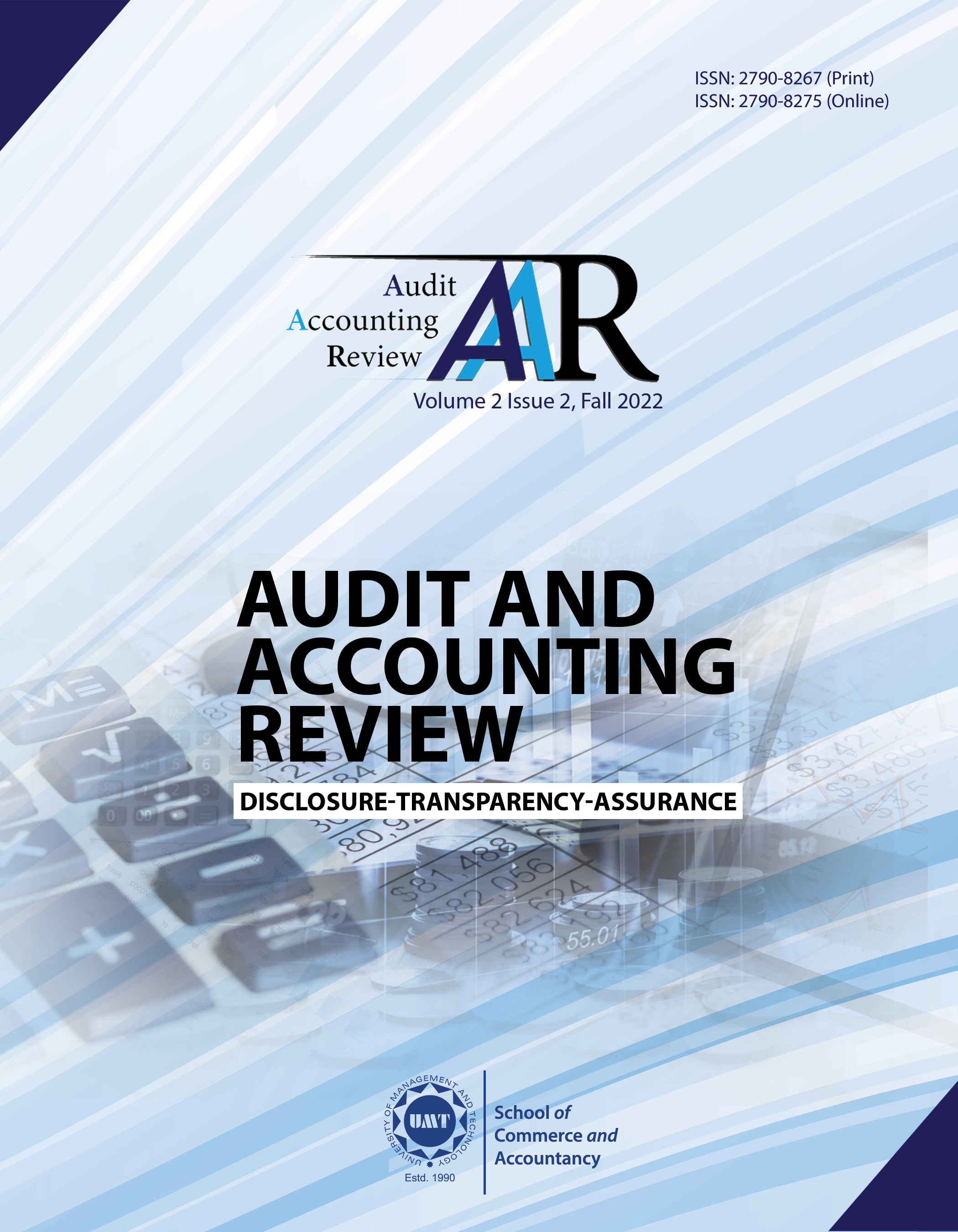Tax Technology, Fairness Perception and Tax Compliance among Individual Taxpayers
Abstract
 Abstract Views: 71
Abstract Views: 71
International Center for Tax and Development estimated that majority of the countries collect 80% of total revenue from taxation. However, most of the developing countries including Pakistan face difficulty in taxation compliance. In Pakistan, taxation system faces a major barrier to compliance in terms of trust deficit among citizens regarding tax authorities. The current study attempted to assess the influence of tax technology on taxation compliance and how it helps to formulate fairness perception about the taxation system. It employed Technology Acceptance model (TAM) to extract the variables of the study according to the local setting of Pakistan. The population of the study consisted of individual tax filers including two segments of the society, that is, salaried individuals and self-employed individuals. Snowball sampling technique was used to collect the data by using a self-administered questionnaire. The selected sample generated 169 complete and useable observations/responses. The data was analyzed by Structural Equation Modeling (SEM) through Smart PLS. The findings indicated a significant direct influence of perceived usefulness, perceived ease of use, and facilitating conditions on tax compliance. Moreover, fairness perception showed a significant positive influence on tax compliance, supported by fairness heuristic theory. The perceived tax fairness significantly mediates the association of the perceived ease of use and facilitating conditions with tax compliance. However, this mediation was not found in the relationship between perceived usefulness and tax compliance. This study could help tax administrators to cope with the issue of trust deficit among tax files and state authorities.
Downloads
References
Abbiati, L., Antinyan, A., & Corazzini, L. (2020). A survey experiment on information, taxpayer preferences, and perceived adequacy of the tax burden. Heliyon, 6(3), 1–9. https://doi.org/10.1016/j.heliyon.2020.e03576
AbdelNabi, M., Wanas, K., & Mansour, S. (2021). How can tax compliance be incentivized? An experimental examination of voice and empathy. Review of Economics and Political Science, 7(2), 87–107. https://doi.org/10.1108/REPS-05-2021-0053
Alm, J. (2019). What motivates tax compliance? Journal of Economic Surveys, 33(2), 1–36. https://doi.org/10.1111/joes.12272
Alm, J., & Torgler, B. (2011). Do ethics matter? Tax compliance and morality. Journal of Business Ethics, 101(4), 635–651. https://doi.org/10.1007/s10551-011-0761-9
Alm, J., Clark, J., & Leibel, K. (2016). Enforcement, socioeconomic diversity, and tax filing compliance in the United States: Tax filing compliance. Southern Economic Journal, 82(3), 725–747. https://doi.org/10.1002/soej.12106
Augustine, A. A., & Enyi, E. P. (2020). Control of corruption, trust in government, and voluntary tax compliance in South-West, Nigeria. Journal of Accounting, 8(1), 84–97. https://doi.org/10.17265/2328-2185/2020.01.011
Augustine, A. A., & Rufus, A. I. (2019). Government transparency moderated by trust in government and voluntary tax compliance behavior in Nigeria. International Journal of Economics, Commerce and Management, 7(8), 624–644. https://ijecm.co.uk/wp-content/uploads/2019/08/7835.pdf
Azmi, A. A., Zainuddin, S., Mustapha, M. Z., & Nawi, Y. (2016). The mediating effect of tax fairness on the relationship between knowledge, complexity and voluntary tax compliance. Asian Journal of Accounting Perspectives, 9(1), 1–12. https://doi.org/10.22452/AJAP.vol9no1.1
Batrancea, L., Nichit, A., Olsen, J., Kogler, C., Kirchler, E., Hoelzl, E., Weiss, A., Torgler, B., Fooken, J., Fuller, J., Schaffner, M., Banuri, S., Hassanein, M., Alarcón-García, G., Aldemir, C., Apostol, O., Bank Weinberg, D., Batrancea, I., Belianin, A., … Zukauskas, S. (2019). Trust and power as determinants of tax compliance across 44 nations. Journal of Economic Psychology, 74, 102–191. https://doi.org/10.1016/j.joep.2019.102191
Becker, G. S. (1968). Crime and punishment: An economic approach. Journal of Political Economy, 76(2), 169–217. https://doi.org/10.1086/259394
Bobek, D. D., Hageman, A. M., & Kelliher, C. F. (2013). Analyzing the role of social norms in tax compliance behavior. Journal of Business Ethics, 115(3), 451–468. https://doi.org/10.1007/s10551-012-1390-7
Bos, K., Lind, E. A., & Wilke, H. A. M. (2001). The psychology of procedural and distributive justice viewed from the perspective of fairness heuristic theory. In R. Cropanzano (Ed.), Justice in the workplace: From theory to practice (Vol. 2, pp. 49-66). Lawrence Erlbaum Associates Publishers.
Bruno, R. L. (2019). Tax enforcement, tax compliance and tax morale in transition economies: A theoretical model. European Journal of Political Economy, 56, 193–211. https://doi.org/10.1016/j.ejpoleco.2018.08.006
Chin, W. W., Peterson, R. A., & Brown, S. P. (2008). Structural equation modeling in marketing: Some practical reminders. Journal of marketing Theory and Practice, 16(4), 287–298. https://doi.org/10.2753/MTP1069-6679160402
Creswell, J. W. (2013). Research design: Qualitative, quantitative, and mixed methods approaches. Sage.
Cropanzano, R. S., Ambrose, M. L., Colquitt, J. A., & Rodell, J. B. (2015). Measuring justice and fairness. In R. S. Cropanzano & M. L. Ambrose (Eds.), The oxford handbook of justice in the workplace. Oxford University Press. https://doi.org/10.1093/oxfordhb/9780199981410.013.8
Davis, F. D. (1989). Perceived usefulness, perceived ease of use, and user acceptance of information technology. MIS Quarterly, 13(3), 319–340. https://doi.org/10.2307/249008
Dom, R., Custers, A., Davenport, S., & Prichard, W. (2022). Innovations in tax compliance: Building trust, navigating politics, and tailoring reform. The World Bank Publications.
Dowling, J., & Pfeffer, J. (1975). Organizational legitimacy: Social values and organizational behavior. The Pacific Sociological Review, 18(1), 122–136. https://doi.org/10.2307/1388226
Drogalas, G., Anagnostopoulou, E., Pazarskis, M., & Petkopoulos, D. (2018). Tax ethics and tax evasion, evidence from Greece. Theoretical Economics Letters, 8(5), 1018–1027. https://doi.org/10.4236/tel.2018.85070
Hair J. F., Sarstedt, J. M., Hopkins, L., & G. Kuppelwieser, V. (2014). Partial least squares structural equation modeling (PLS-SEM): An emerging tool in business research. European Business Review, 26(2), 106–121. https://doi.org/10.1108/EBR-10-2013-0128
Feld, L. P., & Frey, B. S. (2007). Tax compliance as the result of a psychological tax contract: The role of incentives and responsive regulation. Law & Policy, 29(1), 102–120. https://doi.org/10.1111/j.1467-9930.2007.00248.x
Fu, J.-R., Farn, C.-K., & Chao, W.-P. (2006). Acceptance of electronic tax filing: A study of taxpayer intentions. Information & Management, 43(1), 109–126. https://doi.org/10.1016/j.im.2005.04.001
Geisser, S. (1974). A predictive approach to the random effect model. Biometrika, 61(1), 101–107. https://doi.org/10.1093/biomet/61.1.101
Hu, L., & Bentler, P. M. (1999). Cutoff criteria for fit indexes in covariance structure analysis: Conventional criteria versus new alternatives. Structural Equation Modeling: A Multidisciplinary Journal, 6(1), 1–55. https://doi.org/10.1080/10705519909540118
James, S., & Alley, C. (2009). Tax compliance, self-assessment and tax administration. Journal of Finance and Management in Public Services, 2(2), 27–42. https://ore.exeter.ac.uk/repository/bitstream/handle/10036/47458/james2.pdf
Jones, T. M. (1991). Ethical decision making by individuals in organizations: An issue-contingent model. Academy of Management Review, 16(2), 366–395. https://doi.org/10.5465/amr.1991.4278958
Karuru, R. N. (2021). Effects of technological innovations and taxpayer education by Kenya revenue authority on revenue collection in Kenya [Master thesis, Kenyatta University].
Kharisma, A. N. (2018). Influence of tax socialization and level of trust on taxpayer compliance as a micro, small and medium business sector. Russian Journal of Agricultural and Socio-Economic Sciences, 81(9), 330–335. https://doi.org/10.18551/rjoas.2018-09.39
Kim, T.-Y., & Leung, K. (2007). Forming and reacting to overall fairness: A cross-cultural comparison. Organizational Behavior and Human Decision Processes, 104(1), 83–95. https://doi.org/10.1016/j.obhdp.2007.01.004
Kirchler, E., Hoelzl, E., & Wahl, I. (2008). Enforced versus voluntary tax compliance: The “slippery slope” framework. Journal of Economic Psychology, 29(2), 210–225. https://doi.org/10.1016/j.joep.2007.05.004
Kline, R. B. (2011). Principles and practice of structural equation modeling. Guilford Press.
Krejcie, R. V., & Morgan, D. W. (1970). Determining sample size for research activities. Educational and Psychological Measurement, 30(3), 607–610. https://doi.org/10.1177/001316447003000308
Maqsudi, A., Ratnawati, T., & Riyadi, S. (2021). Socialization, service and knowledge matter with taxpayer compliance: An empirical study in Indonesia. The Journal of Asian Finance, Economics and Business, 8(6), 89–95. https://doi.org/10.13106/JAFEB.2021.VOL8.NO6.0089
Mwangangi, A. K., & Memba, F. M. (2022). Online tax system and tax compliance by small and medium enterprises: Case of Kitui County in Kenya. Journal of Accounting, 5(1), 34–58. https://doi.org/10.47941/jacc.1070
Ng, I. C. L., & Tseng, L.-M. (2008). Learning to be sociable: The evolution of homo economicus. American Journal of Economics and Sociology, 67(2), 265–286. https://doi.org/10.1111/j.1536-7150.2008.00570.x
Night, S., & Bananuka, J. (2019). The mediating role of adoption of an electronic tax system in the relationship between attitude towards electronic tax system and tax compliance. Journal of Economics, Finance and Administrative Science, 25(49), 73–88. https://doi.org/10.1108/JEFAS-07-2018-0066
Nurkholis, N., Dularif, M., & Rustiarini, N. W. (2020). Tax evasion and service-trust paradigm: A meta-analysis. Cogent Business & Management, 7(1), 1–20. https://doi.org/10.1080/23311975.2020.1827699
Organization for Economic Co-operation and Development (OECD) (2017). Guidelines for measuring trust. OECD Publishing.
Organization for Economic Co-operation and Development (OECD). (2021). Emerging challenges for the Asia-Pacific Region in the COVID-19 Era. In OECD, Revenue Statistics in Asia and the Pacific 2021. OECD Publishing. https://doi.org/10.1787/5406eccf-en
Olurankinse, F., & Oladeji, O. E. (2018). Self-assessment, electronic-taxation payment system and revenue generation in Nigeria. Accounting and Taxation Review, 2(1), 39–55. http://zbw.eu/econis-archiv/bitstream/11159/4373/1/1695565436.pdf
Perveen, N., Ahmad, A., Usman, M., & Liaqat, F. (2020). Study of investment decisions and personal characteristics through risk tolerance: Moderating role of investment experience. Revista Amazonia Investiga, 9(34), 57–68. https://doi.org/10.34069/AI/2020.34.10.6
Rakhmawati, H., Sutrisno T, S., & Khoiru Rusydi, M. (2020). Influence of TAM and UTAUT models of the use of e-filing on tax compliance. International Journal of Research in Business and Social Science, 9(1), 106–111. https://doi.org/10.20525/ijrbs.v9i1.576
Robbins, P. S. (1992). Essentials of organizational behavior. Prentice Hall.
Saad, N. (2011). Fairness perceptions and compliance behaviour: Taxpayers' judgments in self-assessment environments. [Doctoral dissertation, University of Canterbury]. UC Research Repository. https://ir.canterbury.ac.nz/handle/10092/5065
Schaupp, L. C., Carter, L., & McBride, M. E. (2010). E-file adoption: A study of U.S. taxpayers’ intentions. Computers in Human Behavior, 26(4), 636–644. https://doi.org/10.1016/j.chb.2009.12.017
Silva, F. P., Guerreiro, R., & Flores, E. (2019). Voluntary versus enforced tax compliance: The slippery slope framework in the Brazilian context. International Review of Economics, 66(2), 147–180. https://doi.org/10.1007/s12232-019-00321-0
Simon, H. A. (1955). A behavioral model of rational choice. The Quarterly Journal of Economics, 69(1), 99–118. https://doi.org/10.2307/1884852
Sreejesh, S., Mohapatra, S., & Anusree, M. R. (2014). Business research methods. Springer International Publishing. https://doi.org/10.1007/978-3-319-00539-3
Stone, M. (1974). Cross-validation and multinomial prediction. Biometrika, 61(3), 509–515. https://doi.org/10.1093/biomet/61.3.509
Tambun, S., & Kopong, Y. (2017). The effect of e-filing on the compliance of individual taxpayer, moderated by taxation socialization. South East Asia Journal of Contemporary Business, Economics and Law, 13(1), 1–51. http://seajbel.com/wp-content/uploads/2017/11/ACC-267.pdf
Tusubira, F. N. (2018). Tax compliance by the small and medium-sized corporations: A case of Uganda. [Doctoral dissertation, University of Exeter]. EthOS, e-theses online service. https://ore.exeter.ac.uk/repository/handle/10871/33136
Ullman, J. B., & Bentler, P. M. (2003). Structural Equation Modeling. In J. A. Schinka & W. F. Velicer (Eds.), Handbook of psychology: Research methods in psychology (pp. 607–634). John Wiley & Sons Inc.
Katesh, V., Thong, J. Y., & Xu, X. (2012). Consumer acceptance and use of information technology: Extending the unified theory of acceptance and use of technology. MIS Quarterly, 36(1), 157–178. https://doi.org/10.2307/41410412
Verboon, P., & Goslinga, S. (2009). The role of fairness in tax compliance. Netherlands Journal of Psychology, 65(4), 136–145. https://doi.org/10.1007/BF03080136
Walliman, N. (2006). Social research methods. Sage.
Wang, G., Chen, Q., Xu, Z., & Leng, X. (2020). Can the use of government Apps shape citizen compliance? The mediating role of different perceptions of government. Computers in Human Behavior, 108, 1–11. https://doi.org/10.1016/j.chb.2020.106335
Wittmer, D. P. (2000). Ethical sensitivity in management decisions: Developing and testing a perceptual measure among management and professional student groups. Teaching Business Ethics, 4, 181–205. https://doi.org/10.1023/A:1009866315139
Copyright (c) 2022 Ashfaq Ahmad, Nasira Perveen

This work is licensed under a Creative Commons Attribution 4.0 International License.
Authors retain copyright and grant the journal right of first publication with the work simultaneously licensed under a Creative Commons Attribution (CC-BY) 4.0 License that allows others to share the work with an acknowledgement of the work’s authorship and initial publication in this journal.







